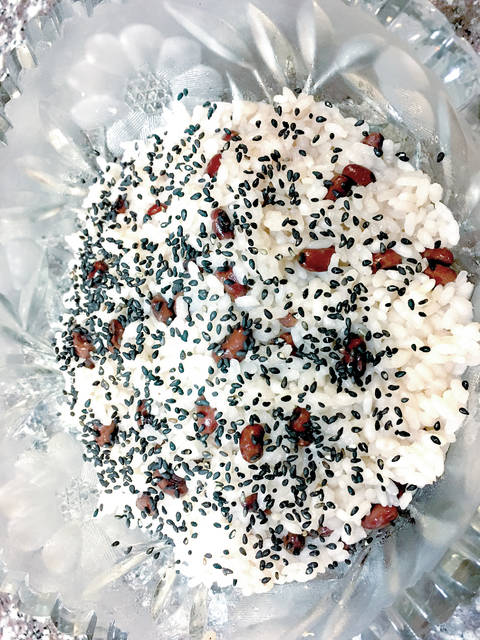Sekihan, or red bean rice, is a traditional dish served during celebratory occasions such as birthdays, weddings and special events. We always depended on our older generation relatives to make it for us, such as my sister’s mother-in-law, Mrs. Hisako Hiraki. Unfortunately, as they age or are no longer with us, it becomes our responsibility to continue the tradition.
I tried many recipes, but was never satisfied with any of them. Some recipes say to soak the mochi and short grain rice for four hours. Some recipes say to soak the azuki beans overnight. The problem with soaking the rice too long is the end result is a very sticky and wet rice. When you soak the beans too long, they start to fracture and break. It is important to keep the beans intact. So our son, Neil, sent me a link to a website, www.nhk.or.jp/dwc/recent/2017/171110.htm, for me to view about how to make the perfect sekihan.
“Our theme for this episode is ‘cooking rice.’ And we’ll be introducing the Japanese celebratory staple sekihan rice. Its chewy texture is beloved all across Japan. We’ll teach you the secrets to making the azuki beans a beautiful red, and the trick to making sesame salt, the perfect finishing touch to bring out the natural sweetness of the beans. We will make it in a special way that even Japanese people don’t know about!”
According to Chef Sato, sekihan was said to “have the power to drive off evil spirits, so sekihan has long been a special dish in Japanese cooking.”
So the science behind this recipe is the mochi and short grain rice are soaked in water for only 30 minutes. This makes the rice cook perfectly and not become sticky or mushy.
The 30-minute cooking of azuki beans and saving the water to add to the rice makes the rice have its distinct red color without adding food coloring.
The pouring of this water several times in another bowl to oxidize the water is important to further redden the water.
The next step to further cook the beans and not saving the water is an important step as the water of the beans after it has been fully cooked is very cloudy and not acceptable. The 30-minute cooked water is red, clear and clean.
The azuki beans are not pre-soaked, so the beans do not break up.
The many steps seem to be tedious, but it’s worth the effort as your results will be worth it.
Sekihan, or
Red Bean Rice
Combine, wash until water runs clear:
2 cups mochi rice (glutinous rice)
1 cup short grain white rice
Soak in water for 30 minutes. Drain.
In a small pot, combine with just enough water to cover:
1 (100 grams) package dried azuki beans
On high heat, boil for 30 seconds, strain and discard liquid.
Add to azuki beans:
2 cups water
On high heat, when it comes to a boil, turn heat to low and simmer for 20 minutes.
Drain liquid into a bowl. Pour this water into another bowl about 5-6 times to oxidize the azuki water and turn it a brighter red.
Place drained azuki beans into a pot with:
2 cups water
Boil, then simmer until the beans are fully cooked, about 40-45 minutes.
When cooked, gently transfer into a strainer (so as to not break any of the beans) and cover with a damp cloth.
To make sesame salt, combine:
1/4 cup sesame seeds
1 teaspoon salt
Add enough water to moisten in a fry pan and thoroughly heat over low heat until water is evaporated and sesame seeds no longer stick together.
This process makes the sesame seeds salty and you will not have salt crystals.
In a rice cooker, combine the mochi and short grain rice, measure off:
1 2/3 cups azuki water
1 tablespoon sake
Set to cook.
When rice is done cooking, add the cooked azuki beans on top, and allow to steam 5 minutes, then gently mix in the beans.
Serve with sprinkled sesame seeds scattered on top.
Koreans have a similar dish, “patbap,” which is eaten during winter months and holidays.
Foodie bites:
• Gut health is going to be important in 2018, according to Pollack Communications and Today’s Dietician’s
survey.
The rise of fermented foods such as yogurt, kefir, kombucha, sauerkraut, tempeh, kimchi, miso, natto and some pickles are going to be in more people’s diets as we are working toward clean, natural and simple foods that will improve our gut health and overall well-being. Jenna A. Bell, PhD, SVP of Pollack Communications states, “Consumers are searching for nutrition information and equating diet with overall well-being.”
Bell points out there is a rise of fermented foods in the top 10 superfoods lists. “It also suggests that consumers are digging deeper for information about the food they eat and, in this instance, finding out why yogurt, kefir or kimchi is so good for them.” So, have you had your fermented food today?
• Hawaii Community College’s Culinary Program’s Cafeteria opens Wednesday (Jan. 10). Hours are 10:30 a.m.-12:30 p.m. Tuesday through Friday. Takeout orders are welcomed; call 934-2559. Call to inquire for desserts for the day. Two choice combinations are now available for any of the four entrees served daily. Prices vary. Poke bowls and chirashi bowls will be on the menu when fresh fish is available. Call to inquire about availability.
Email Audrey Wilson at audreywilson808@gmail.com.






